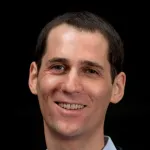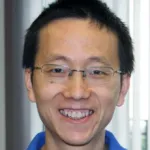
Screenshot from video of simulations by Simulations by Naomi Latorraca, Sam Hertig and Ron Dror: Simulations show how sugar is transported across the cell membrane. Transporter proteins, represented by yellow and purple ribbons, change their structure to do their work. The first simulation begins with the protein in the outward-open structure, which allows a pink sugar molecule to move up and out. In the second simulation, the protein begins in the same outward-open structure but then transforms to the inward-open structure, allowing the sugar molecule to move down and into the cell.
Stanford News - April 13th, 2017 - by Shara Tonn
Inside every plant or animal, proteins called transporters act as cellular doorkeepers, letting nutrients and other molecules in or out as need be. Although transporter proteins are critical for normal cell function – and are key targets for many drugs – scientists have never really understood how they open and close.
Now Stanford researchers have created a realistic simulation of a transporter protein moving a sugar molecule across a cell membrane. The simulation, described in Cell, could improve the development of drugs, many of which work by manipulating transporters. For example, these proteins ferry dopamine, serotonin and other neurotransmitters in and out of cells, making them key points of interest for treating psychiatric disorders such as depression. In addition, most drugs must evade ejection from cells by transporters to be effective.
“Now that we have a better understanding of how transporters work we can break down the process and see what’s actually important,” says Liang Feng, an assistant professor in molecular and cellular physiology, who co-authored the paper with Ron Dror, an associate professor of computer science.
Transporter basics
Transporter proteins sit snugly in the cell membrane. They have two gates: One opens to the outside of the cell and the other to the inside. In the late 1960s, scientists theorized that transporters could only have one gate open at a time, much like an airlock system in a spacecraft. But since proteins are too small to be seen through a microscope it wasn’t possible to verify the idea.
Instead, scientists had used a technique called crystallography to decipher the shape of a protein. Combining such static images with biological experiments, they could extrapolate how transporter proteins might behave.
But Feng wanted to go further. “We wanted to figure out how these molecules change shape to realize their function,” he said.
Dynamic simulation
The more dynamic view of a transporter in action came about through conversations between graduate students Nathan Fastman and Naomi Latorraca. Fastman, a graduate student in Feng’s lab, was intimately familiar with a particular sugar transporter. Latorraca was a graduate student in Dror’s lab who specialized in modeling molecular dynamics on an atomic level. These types of simulations have become more powerful with improvements in computer technology.
“Plus, the underlying physics models have become more accurate, and we now use better algorithms,” Dror said.
Fastman discovered crystallography images of a transporter in different stages of the transport process, which provide starting points for simulations. Starting with just one structure, Latorraca and Dror programmed in the physical forces between atoms, then stepped back and let the simulated atoms move spontaneously.
From that starting point, the simulation found structures that match the two other crystallographic states. The simulation also supported the airlock theory of how the transporter worked. It showed that the forces between the atoms are such that the protein is most stable with just one or the other of the two doors open, or with both closed, but not with both open.
“The beauty of this paper is the simulation and the experimental evidence match really well, so we know the simulation is very likely to be real,” Feng said.
Dror said revealing the inner workings of transporters will benefit medical research.
“For example, one could treat diseases like diabetes by creating drugs that bind to and regulate transporters,” he said, “and preventing drugs from getting thrown out of cells by transporters would help avoid problems such as antibiotic resistance.”
Other contributors to the paper, “Mechanism of substrate translocation in an alternating access transporter,” include A. J. Venkatakrishnan, a postdoctoral fellow in Dror’s lab, and Wolf Frommer of the Carnegie Institution for Science.
This work was funded by Stanford Bio-X, the National Institutes of Health, the Department of Energy, the Harold and Leila Y. Mathers Charitable Foundation and the Alfred P. Sloan Foundation.


